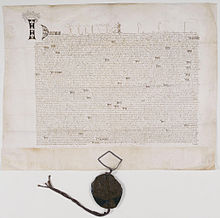Today, June 2nd, is the six hundredth anniversary of the wedding of King Henry V to Catherine of Valois, the final act in the events around the making of the Treaty of Troyes in 1420.
Under the terms of this King Henry V was to become heir to the French throne and to act as Regent of France until the death of King Charles VI, when he would succeed him. As part of the agreement the English King was to marry the French King’s daughter Catherine. This marriage was not a new proposal - it had been raised in negotiations in 1408, 1409, 1413 and 1415. Her brother the Dauphin Charles, who ultimately did become King Charles VII, was disinherited.
There is a discussion of the Treaty of Troyes, with quotations from original sources, and a series of reflections on its implications which can be read at Treaty of Troyes and Trouble Ahead
Image: ArchivesNationales
The final negotiations took place in the cathedral of St Pierre et St Paul in Troyes.

Troyes Cathedral
Image: Wikipedia
In the negotiations in the cathedral, with Queen Isabeau to the fore on the French side and the English king supported by the young Valois Duke of Burgundy, alienated from his dynasty by the murder, apparently with the connivance or acquiescence of the Dauphin Charles, of his father the previous autumn, what was envisaged or presented as a final peace was set out. The Hundred Years War, which had begun in 1337, but in reality a generation or more earlier, would end with a new Great Peace as in 1361.
That one had not lasted, with the campaigning resuming in 1369, and nor was this to last - but both were impressive on parchment.
King Charles VI by the Master of Boucicaut 1412
Image:Wikipedia
Queen Isabeau receiving Christine de Pisan's Le Livre de la Cité des Dames, c. 1410–1414.
Image: British Library and Wikipedia
Image: Wikipedia
The wedding ceremony is sometimes said to have been in the cathedral but most authorities these days place it in the church of Saint-Jean-au-Marché, which lies to the west of both the the cathedral and the incomplete Basilica of St Urbain. The church has been considerably altered and restored since 1420, but parts of it - the nave and its aisles - are as they were on that remarkable wedding. For that occasion King Henry insisted the ceremony should be after the French fashion, presumably to indicate parity between the two realms. That is reminiscent of Queen Mary I stressing English customs at her marriage in 1554.
The great question that arises is, of course, was such a union of the two realms possible. Crucial factors in its failure were the deaths of King Henry V in 1422, two months before King Charles VI, and the desertion of his English alliance by Duke Philip of Burgundy in 1435. Those and a royal minority in England, plus Jeanne d’Arc appearing on the scene in 1429 made the realisation of the Treaty well nigh impossible.
However if we stand with the crowds which doubtless were gathered to see the happy couple, the 33 year old King and his 18 year old bride, leave St Jean that day perhaps such an outcome did seem not so likely.
Unions of realms such as Troyes envisaged were not uncommon from the later Middle Ages onwards. Denmark, Norway and Sweden were united in the Union of Kalmar from 1397 (Henry’s sister Philippa was married to its King) and lasted until Sweden seceded in 1523. Denmark and Norway shared a monarch until to 1814, then Sweden and Norway until 1905. Poland was under the same king as Hungary 1370-82, and his daughter’s marriage united Poland and Lithuania in the period 1386-1795. Castile and Aragon have been united in a dynastic union since 1474/9, and were in one with Portugal in the period 1580-1640. Austria and Hungary-Bohemia were linked under a shared ruler from 1526 to 1918.
England and Scotland have been in a dynastic union since 1603, and Great Britain and Hanover were in one from 1714-1837. The Prussian kingdom also came about in essence through branches of the same family linking through inheritance Ducal Prussia to the Electorate of Brandenburg.
Not a few of these unions were tempestuous or foundered temporarily or ultimately but their duration is still striking.
English exceptionalism notwithstanding there is the point made by K.B.Macfarlane in his famous 1953 essay on King Henry V, and perhaps endorsed by some other historians, that if anyone could make the envisaged Dual Monarchy work it was Henry.
The French, being French, do not celebrate the Treaty which they often brand as shameful. When I visited Troyes some years ago I noticed a plaque on the cathedral recording the visit of King Charles VII with Jeanne d’Arc in 1429, but no commemorative plaque for the 1420 Treaty. Funny that...
However a Troyes tourist site does speak of the more positive potentialities of the Treaty:
Some historians call the 1420 Treaty of Troyes the “shameful treaty”, because it “handed” control of France to the English. This unwanted label became commonplace some three centuries later with the birth of the concepts of the nation and nationalism.
Yet a close inspection of the treaty would suggest that, in the context of the time, the treaty was actually extremely “modern”. As well as establishing peace between two warring factions, it also respected the identity of both parties and introduced the concept of ongoing dialogue between peoples, particularly through the development of trade.
In that sense, it is rather similar to the Common Market and the subsequent European Union, which came some six centuries later. And what if this treaty was more than just a visionary text? Some modern historians have drawn parallels between the Treaty of Troyes and the Declaration of Union of Britain and France, approved by De Gaulle and Churchill on 16 June 1940: “France and Great Britain shall no longer be two nations, but one Franco-British Union”.
Article 24 of the Treaty of Troyes reads as follows:
“The two crowns of France and English shall for evermore be united as a single entity”. Later, the treaty talks of “accord, mutual affection, firm and stable friendships”
So, welcome to Troyes...
Something like that ephemeral 1940 arrangement was again tentatively suggested by the French government in the period before the 1957 Treaty of Rome.
As for the English, despite a few articles in popular history magazines - and allowing for the current health emergency - in the age of Brexit there seems no appetite for commemorating one of the most spectacular, if short-lived, diplomatic successes. Funny that as well...






No comments:
Post a Comment